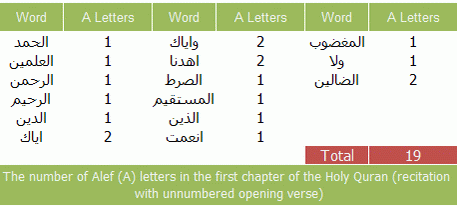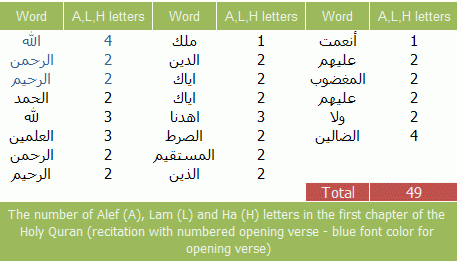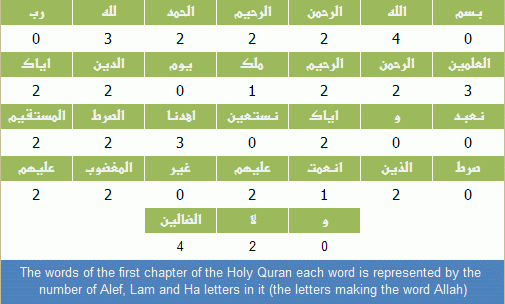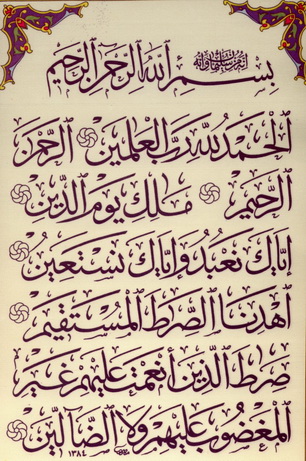In this article I will present recently discovered mathematical phenomena in the first chapter of the Holy Quran (The opening chapter). The first chapter of the Holy Quran is named "Al Fatiha" "الفاتحه" which means "The key" i.e. "The chapter that starts the Book". This chapter is of tremendous importance in Islam and in the life of Muslims. It is recited in order to glorify Allah - God Almighty and it is a prayer wherein the reciter asks Allah for guidance and support. A Muslim recites this chapter at least 17 times in the 5 daily prayers. Without it the prayer (Salat) is not complete. The significance of this particular chapter can be seen in the fact that it is placed at the very beginning of the Holy Quran. This chapter has 17 different names such as: "Book's Mother", "Doubler Seven" (since it has 7 verses and each two verses explain each other), it is named also "The Cure", "The Sufficient", "Base", "Gratitude", "Treasure" and many other names.
Here's the original revealed text in Arabic (Followed by English translation):
|
|
|
ENGLISH: (a) All creation |
As can be seen the reciter of this chapter will be expressing the main pillars of faith and in the words of Prophet Muhammed (Peace be upon Him) "this chapter is equivalent to the whole Quran".
Before proceeding to the mathematical phenomena found here I would like to make a point clear about the Holy Quran. The Holy Quran is the word of Allah - Jehovah God that was revealed unto Muhammed (محمد) son of Abd Allah son of Abd Al Mutalib of the House of Hashim between the years 610 CE and 632 CE. The Quran was revealed in Arabic language. It was written down and learned by heart by Prophet's followers during his life ime and it was gathered short time after his death. The way words are wirtten in the Quran is also a revelation by God through arch angel Gabriel (Peace be upon him). The Quran has 7 different recitation versions (called Qira'at - singular: Qira'a) that follow different dialectis spoken by the Arabs at time of revelation. The different Qira'at don't differ in conveyed meanings and messges. Diffrences among them take the form of alternating ways of reading some words (a thing that expands the meaning of the verses) or the differences concern the way verses are numbered (joined together or split apart). Again differences that has no impact on overoall meaning. In fact, the different Qira'at constiture the ultimate challenge and miracle of this Scripture.
When it comes to the first chapter of the Holy Quran the main difference among the different Qira'at, that concerns what will be presented here, relates to the first verse of this chapter. Some Qira'at count it as an integrated part of the chapter (i.e. that it is verse number 1) while others do not count it as part of this chapter. The opening verse is "بسم الله الرحمن الرحيم" which means "In the name of God, The Compassionate, The Merciful". This opening verse has its own mathematical wonders as can be seen here. Most of what will be presented here relates to Qira'at such as the recitation of Qaloon An Nafia' (where the opening verse is not numbered and counted as part of chapter). Other phenomena seen in recitations such as that of Hafs An A'asim (where the opening verse is part of the chapter) will also be presented.
Some information about this chapter:
- It has 7 verses
- It consists of 29 words (and two conjunctive waws - واو العطف)
- It consists of 139 letters
- It's the 5th revealed chapter of the Holy Quran
Now to the mathematical wonders of this chapter:
Many of the phenomena presented here relate to the key miracle number in the Quran number 19. This number is a prime number which means that it is divisible only by itself and one. But why 19 ?! Is there a divine reason for using the number 19 instead of some other number as a coding number for Scripture ?! Besides being a prime number, the number 19 is the gematrical value of the word "ONE" in all scriptural languages Aramaic, Hebrew, and Arabic. For example, in Arabic, the word for "ONE" is "WAHD" "واحد". The gematrical values of the letters W, A, H, and D are 6, 1, 8, and 4, respectively. These numbers add up to 19 (6+1+8+4=19).
Therefore, the number 19 can be looked at to signify the First Commandment in all scriptures that there is only ONE God.
1st Fact
Many of the facts presented here concern the letters of the first chapter as they are represented by numerical values. I guess one of the simplest ways to represent the first chapter is by giving each letter a value according to its order of appearance among all the letters making up the whole chapter. Let us take an example. Here is a popular translation for the very first words revealed by God in Genesis chapter one.
![]()
As can be seen above each letter gets a value representing its order of appearance in the verse. A repeated letter gets the same initial value it was assigned.
The first word of chapter number one of the Holy Quran is "الحمد" (pronounced "Al-hamd" meaning: praise). Alef ( ا ) is the first letter of this word and gets thus the numeric value 1. Lam ( ل ) is the second letter to appear and gets the value 2. We continue assigning values in this manner: H'aa' ( ح ) gets the value 3, Meem ( م ) gets the value 4 and Dal ( د ) gets the value 5. This process of assignig letters values according to thier order of appearance in the chapter is continued until the end of the chapter. Letter Dad gets the highest value of 21 (it is the last letter to appear among the words of the chapter).
Doing this regarding the first chapter of the Holy Quran (without opening verse following the recitation of Qaloon An Nafia') and putting the values for each letter side-by-side right-to-left (as Arabic language is) we get a huge number consisting of 165 digits. This number is perfectly divisible by key miracle number 19 (i.e. with no remainder).
Here is the number:

The huge number and result of division can be found in this plain text file.
A table with all letters and their values can be found here.
2nd Fact
We do exaclty the same as in fact number one to the first chapter of the holy Quran witth the exception that the process of assigning lettes values starts from the opening verse itself. The opening verse is regarded as an integral part of the first chapter in some recitations, whereas in others it is not. The opening verse is "بسم الله الرحمن الرحيم" which means "In the name of God, The Compassionate, The Merciful". The first letter is Baa and gets thus the numeric value 1, the second letter to appears is the letter Seen and gets thus the value 2, the third letter to appear is Meem and gets the value 3. As we can see the Arabic letters get different numeric values than those deduced under fact number one.
After finding out the numeric values of the 21 letters that compose the first chapter of the Holy Quran as described above, we represent each letter of the chapter (without the opening verse itself - the part from "الحمد لله رب العلمين" - English: "Praise to God.." to end of chapter) by the deduced values. Putting these values side-by-side right-to-left results in a huge number consisting of 163 digits. This number is also divisible perfectly by key number 19.
Here is the number:

The huge number and result of division can be found in this plain text file.
A table with all letters and their values can be found here.
There is no mathematical necessity that both numbers should be divisible by 19. Please consult the tables to see that.
3rd Fact
Here and in the next three points we will be using letter-value systems derived from the Holy Quran and we will be dealing with the first chapter of the Holy Quran following the recitation of Qaloon An Nafia' (i.e. without the opening verse). There exist some letter-number tables where each letter of the Arabic alphabet is given a particular numerical value. These systems are based on numerous research and findings in the Holy Quran. Each time, we will be giving each letter of this chapter a value according to the table of interest and put all values side-by-side right-to-left.
The first letter-value system we will be using is based on the names of Allah - Jehovah God mentioned in the Holy Quran. The special thing about this table is that many names of God, using these values, get totals that are all divisible by 11. The word Allah - God - الله itself gets the total 11. Number 11 is a prime number (it cannot be devised by numbers other than itself and one). This number signifies God Almighty. the eternal unchanged Creator.
To mention some of the names of God in the Holy Quran: The Beneficent (الرحمن), The Merciful (الرحيم), The Sovereign Lord (الملك), The Guardian (المهيمن), The Omniscient (العليم). Full list can be found here: Names of God in Islam (Wikipedia)
Here's the table:
أ=1 ل=2 ر=3 ح=4 م=5 هـ=6 ن=7 ب=8 ص=9 ط=10 ء(الهمزة)=11 ق=12 و=13
د=14 ع=15 خ=16 ت=17 ي=18 ك=19 ف=20 ذ=21 ث=22 س=23 ش=24 ظ=25 ز=26
غ=27 ض=28 ج=29
This table originates from the work of Mr. Abd Al Daim Al Kaheel. More information can be found here.
So, we take each letter of this chapter, assign it a value accoridng to this system and put all the values side-by-side right-to-left. The number we get consists of 163 digits. This huge number is divisible by 19. It is also divisible by 7 which is also a key miracle number.

The huge number and resulkt of division can be found in this plain text file.
4th Fact
We use yet another letter-value system. This time a table which is based on the number of occurrences of the Arabic language letters among the mysterious Quranic initials. Some chapters of the Holy Quran are initiated by mysterious strings of letters, such as A, L, M (الم) or E, S (يس). These letters convey no semantic meaning and no one is 100% sure what is the ultimate purpose of these letters but many researchers maintain that these are challenging keys that hide numeric systems & phenomena that prove the Divine origin of this Book. There are 29 Quranic initials (14 unique ones - i.e. repeated excluded) which are made of 14 unique letters out of the 28 letters making the Arabic language alphabet.
In this table each letter of the 14 letters appearing among the Quranic initials takes a value according to how many times it appears among the 29 initials. Letters not appearing among the initials take the value zero.
Here's the table:
أ=13 ل=13 م=17 ص=3 ر=6 كـ=1 هـ=1 ي=2 ع=2 ط=4 س=5 ح=7 ق=2 ن=1
This table originates from the work of Mr. Mowafaq Mostafa Saa'ed. More information can be found here.
So, we give each letter of the opening chapter a value according to this table and put the numbers side by side right-to-left. The result is a 169 digit number that is also divisible by 19.

The huge number and result of division can be found in this plain text file.
5th Fact
The next letter-value system is based on the above metioned Quranic initials but this time each letter is assigned a value according to its order of appearnce witihin the initials. The first initial is A, L, M (الم) in chapter number 2, therefore the A ( ا ) gets the value 1, L ( ل ) gets the value 2 and M ( م ) gets the value 3. We do the same to the rest of the initials' letters up to the last letter N ( ن ) (in chapter 68 - The Pen) which gets the highest value of 14. Here is the table with the values:
أ=1 ل=2 م=3 ص=4 ر=5 كـ=6 هـ=7 ي=8 ع=9 ط=10 س=11 ح=12 ق=13 ن=14
We give each letter of the opening chapter a value according to this table and put the numbers side by side right-to-left. The result is a 138 digit number that is also divisible by 19.

The huge number and result of division can be found in this plain text file.
6th Fact
Here we apply a third letter-value system named Islamic Gommal (الجمل الإسلامي). This table is based on the meaning of Arabic words in the Holy Quran where the values different words take reflect semantic relationships among them. The system is based on the occurrences of Arabic language roots in the Holy Quran. Here is the table extracted after research of the words of the Holy Quran:
أ=1000 س=900 ن=800 ع=700 ح=600 ر=500 ق=400 و=300 م=200 ص=100 ك=90 ل=80 هـ=70 د=60
ط=50 ي=40 ب=30 ف=20 ج=10 خ=9 ش=8 غ=7 ز=6 ض=5 ت=4 ث=3 ذ=2 ظ=1
This table originates from the work of Mr. Muhammad Obayd Allah. More information can be found here.
Giving each letter of the opening chapter of the Holy Quran a value according to this table and putting the values side by side right-to-left provides a number consisting of 316 digits that is divisible by 19.

The huge number and result of division can be found in this plain text file.
Note: The facts mentioned above (In facts 3, 4, 5 and 6) all concern the first chapter of the Holy Quran without the opening verse (as in the recitaion of Galoon An Nafia'). For letter-value table under fact 3 we still get a huge number divisible by 19 even when having the opening verse as part of this chapter. Pay attention that the same letter value systems mentioned under fact 3 & fact 4, when applied to chapter 76 "Human being", give huge numbers (+1429 digit) that are both divisible by human chromosome number (46) which was discovered in the year 1955 by advanced microscope techniques.
ALL numbers mentioned above can be found in the attached PDF file. See below.
7th Fact
Most of the above mentioned facts concern the first chapter of the Holy Quran without the opening verse (as in the recitation of Qaloon An Nafia'). An interesting fact is that this chapter (without a numbered opening verse) contains 19 Alef (A) ( ا ) letters! The special thing about the letter Alef is that:
a. It is the first letter of the first chapter of the Holy Quran (without opening verse), that is in the word Alhamd - الحمد - (Praise).
b. It was the first revealed letter of the Holy Quran (First verse of chapter 96).
Letter Alef relates to numerous mathematical phenomena in the Holy Quran. For example it relates to human chromosome number in chapter 76 (named Human being - الإنسن), as there are exactly 199 Alef letters in that chapter. The truly interesting thing is that 199 is the 46th prime number in the universe and that human beings have 46 chromosomes (different species have different number of chromosomes, e.g. the elephant has 56 chromosomes while the hoopoe bird has as many as 126 chromosomes). This same number, 199, can be seen in different places in the Holy Quran in relation to human creation. In fact, prime numbers themselves are building blocks of the Holy Quran as has been established by numerous findings. Here is the table with the A ( ا ) letters in chapter one:

8th Fact
Number 19 keeps to surprise us. As can be seen in the table under fact number 9, there are exactly 19 words containg one or more of the three letters making the word Allah ( الله ) - God in the first chapter (as in most of the facts presented so far: without opening verse). The three letters that build the word Allah are: Alef ( ا ), Lam ( ل ) and Haa ( ه ).
9th Fact
The mathematical wonders of the Quran are not restricted to number 19 but include also the number 7. Both 19 & 7 are prime numbers which means that they are divisible merely by themselves and one. Holy Quran's verses and prophet sayings point to the centrality of number 7 in the Holy Quran and creation. This number is also central in Biblical studies. The first chapter of the Holy Quran consist of 7 verses (including the opening verse). There are lots of phenomena in the first chapter that relate to the number 7. When counting the number of Alef ( ا ), Lam ( ل ) and Haa ( ه ) letters (the ones that make the word Allah - Holy Quran's author) in this chapter (including opening verse) we find them to be 49 letters. The number 49 is equal to 7 × 7. The total without the opening verse is 41 which is an established value of the word Allah ( الله ) - God as deduced from the occurrences of the mysterious Quranic initials (to increase our confidence in the particular related letter-value system I would like to mention that the value of the word "Human being" (الإنسن) according to those same values is 46 which is equal to human chromosome number, discovered in the year 1955).
Here is the table with all the words of the first chapter of the Holy Quran that include at least one letter of the three letters that make the word Allah ( الله ) - God. Next to each word you can see the number of those three letters inside it. The three words in blue color are those found within the opening verse. The three words are a. God ( الله ) b. The Gracious ( الرحمن ) c. The Merciful ( الرحيم ).

10th Fact
Let's pay the table under fact 9 further consideration. The distribution of those 49 letters (or the 41 without the opening verse) is not random at all. It looks like this chapter has countless amount of mathematical stuctural systems. A common method of representing words and letters numerically is by expressing each word by the number of particular letters inside it. For example, chapter 76 "Human being" and chapter 96 "The clot" (a name relating to human creation) when represented by similar methods give huge numbers (278 and 76 digit numbers) that divide perfectly by human chromosome number (46). What we will do here is to express each word in this chapter by the number of Alef ( ا ), Lam ( ل ) and Haa ( ه ) letters (the letters making the word Allah) inside it. For example the first word Bism (بسم) gets the value 0 while the second word Allah (الله) gets the value 4 (note: this word is written by 4 letters in Arabic language). After that we put all the values side by side right-to-left as Arabic language is. Here is a table with the individual word values:

The resulting number is a 31 digit number:
4202202120223020022012230322240
(opening verse values are underlined)
This number divides perfectly by miracle number 7. It is equal to 7 × 600314588603288574573175760320. Even the number representing this chapter without the opening verse (a 27 digit number) divides perfectly by 7. The number is equal to 7 × 60031458860328857457317576.
The incredible thing about all what have been mentioned so far is that all those mathematical phenomena are seen in the same 139 letters making the opening chapter of the Holy Quran, a chapter that expresses all the main themes in Muslim belief and which is written in flawless, top quality & challenging Arabic language.
Let's see what God says in chapter 25 (The Criterion - الفرقان) of the Holy Quran:
"(4) And the infidels say, "This Koran is a mere fraud of his own devising, and others have helped him with it, who had come hither by outrage and lie." (5) And they say, "Tales of the ancients that he hath put in writing! and they were dictated to him morn and even." (6) SAY: He hath sent it down who knoweth the secrets of the Heavens and of the Earth. He truly is the Gracious, the Merciful."
"وَقَالَ ٱلَّذِينَ كَفَرُوٓا۟ إِنْ هَـٰذَآ إِلَّآ إِفْكٌ ٱفْتَرَىٰهُ وَأَعَانَهُۥ عَلَيْهِ قَوْمٌ ءَاخَرُونَ ۖ فَقَدْ جَآءُو ظُلْمًا وَزُورًا * وَقَالُوٓا۟ أَسَـٰطِيرُ ٱلْأَوَّلِينَ ٱكْتَتَبَهَا فَهِىَ تُمْلَىٰ عَلَيْهِ بُكْرَةً وَأَصِيلًا * قُلْ أَنزَلَهُ ٱلَّذِى يَعْلَمُ ٱلسِّرَّ فِى ٱلسَّمَـٰوَٰتِ وَٱلْأَرْضِ ۚ إِنَّهُۥ كَانَ غَفُورًا رَّحِيمًا
Much more to come under this topic. Please visit this page later !
- The Holy Quran - Revelation of Allah - Jehovah God
- www.qurancomplex.com King Fahd Complex for the Printing of the Glorious Quran
- Factorization by Elliptic curve method
- Wikipedia - The free encyclopedia - Chromosomes


Comments
Thanks brother for all the
Thanks brother for all the efforts. It is unreasonable to think that these mathematical phenomena are there by mere chance. God is right about saying that He is the fastest mathematician (not sure which verse in Quran He says this). But I want to ask, how did you generate the numbers ?! How certain are you that these numbers are correct ?! After all they are really huge numbers ...
God bless you!
Thanks! I have discovered
Thanks! I have discovered these interesting numbers in the summer of 2009. I generated the numbers first manually and tested them by ECM factorization utility. I also was worried about error possibility so I adopted a Java-Script from the net that replaces letters with values. I put the letter-value systems in and checked the text again. Amazingly ALL numbers are correct and ALL are divisible by 19.
I want to emphazise that there is no whatsoever mathematical necessity that all those numbers should be perfectly divisible by key miracle number 19. Sub7an Allah!
Can i try do it by myself. to actually see it?
Hey. Yes these numbers are indeed big numbers. But i want to know how you found these numbers? Yes you used this program named ECM factorization utility, but i want to know how to use it. I mean i want to try to input the sura al fatiha, by my self. and really see that its true Then i would really believe it. Do you have any idea how i can do that?
Thank you :)
You have to generate the
You have to generate the numbers mentioned in the first two facts manually as described. Here are the three html files with javascript that can be used to generate the other three big numbers:
Letter-value-system base on the 99 names of God - Allah
Islamic Gommal letter value system
Letter-value-system base on letter occurrences in the Quranic initials
a) Insert the text in the first box b) reverse (to match Aranic language) c) copy and past into second box d) encode e) use a factorization utility.
It would be nice if you could provide feedback :)
thank you :)
helped alot ;) i will remember it next time ok? :D
The Number 19 and the Holy Qur'an
Salaam. Interesting research, iqwa. Jazak-Allah Khairun for your work.
Great work. "There are signs
Great work. "There are signs for those that believe".
Extreme knowledge
i think all the fact of universal which found and which to be found is in the quran in different condition. some fact is in plan text, some in the numbers, some in the calculations, some in binary language and WALLAH-O-ALAM...... where where it is. Quran is the not only a book but a manual book of universe. it need to be extreme search. as you did for the first chapter. You have to spend you life in this search and new generation will continued. a time will come when every one says we all wasted our time in search of hidden facts even we have Quran.
could not understand fact 3
could not understand fact 3 and fact 6 brother.... can u please explain the letter value system in those 2 facts? thank u in advance... gr8 effort...
@Khalid Mahmud
@Khalid Mahmud
Asalam Alaykom brother,
Those systems were not developed by me personally. I just applied them on the First Chapter. As for the one by Mr. Al Kaheel, the values when representing many names of Allah give totals divisible by 11.
I hope more information would be available from the original authors in the near future.
Add new comment